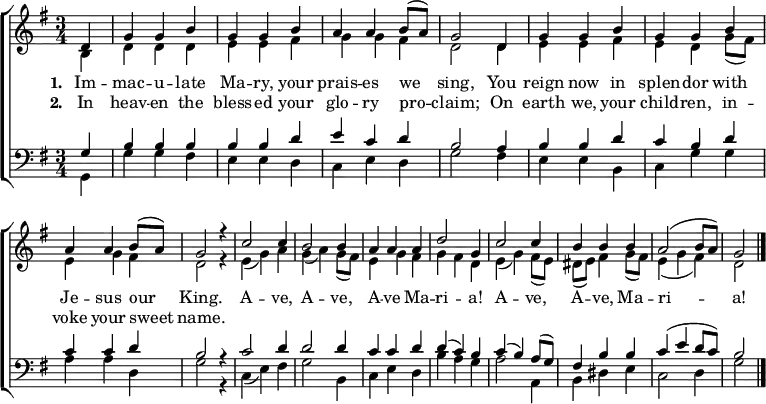Immaculate Mary
"Immaculate Mary" or "Immaculate Mother" (French: Ô Vierge Marie) is a popular Roman Catholic Marian hymn. It is also known as the Lourdes Hymn, a term which also refers to the hymn tune itself. It is often sung in honour of the Immaculate Conception of the Blessed Virgin Mary.[1]
| Part of a series on the |
| Mariology of the Catholic Church |
|---|
 |
|
|
The earliest version of the hymn was written in 1873 by French priest and seminary director Jean Gaignet, for pilgrims to the site of the apparitions of Our Lady of Lourdes. It was set to a traditional French tune and contained eight verses;[2] he later expanded it to 120 verses.[3]
Versions
Several versions of the hymn are in use in different parts of the world. Many of them are original sets of lyrics in various languages, set to the same tune, theme, and refrain.
A popular version dating to 1952[4] is as follows:
- Immaculate Mary, thy praises we sing,
- Thou reignst now in Heaven with Jesus our King.
- Ave, Ave, Ave Maria! Ave, Ave, Ave Maria!
- In Heaven the Blessed thy glory proclaim,
- On earth we thy children invoke thy fair name.
- Ave, Ave, Ave Maria! Ave, Ave, Ave Maria!
- We pray for our mother, the Church upon earth
- And bless, dearest Lady, the land of our birth.
- Ave, Ave, Ave Maria! Ave, Ave, Ave Maria!

Another popular version which appeared in hymnals between 1900 and 1975 has, as its first line, "Immaculate Mary, our hearts are on fire."[5] It extends to around 12 verses in order to facilitate its use in processions.
In the Philippines
A different text is sung at novena services and Masses honouring Our Lady of Perpetual Help, as well as Marian processions in general. This version is commonly associated with Baclaran Church, the Philippine's national shrine for the icon and its devotion.
| English | Filipino |
|---|---|
|
|
Notes
- Maiden and Mother: Prayers, Hymns, Devotions, and Songs to the Beloved Virgin Mary Throughout the Year by Margaret M. Miles 2001 ISBN 0860123057 page 60
- Guérin, Benoît. "Ce prêtre vendéen qui créa l'Ave Maria de Lourdes". Ouest-France.fr (in French). Retrieved 7 June 2017.
- Gaignet, Jean (1875). Cantique-récit de l'apparition de N.-D. de Lourdes en six dizaines de strophes. impr. de H. de Broca.
- Budwey, Stephanie (2014). Sing of Mary: Giving Voice to Marian Theology and Devotion. Liturgical Press. ISBN 9780814682937.
- "Immaculate Mary, our hearts are on fire". Hymnary.org.
References
- Immaculate Prayers Immaculate Conception Prayers
- Catholic Doors Immaculate Mary
- Catholic Culture Liturgical Year : Activities : Enthronement of Our Lady of Guadalupe
.JPG.webp)